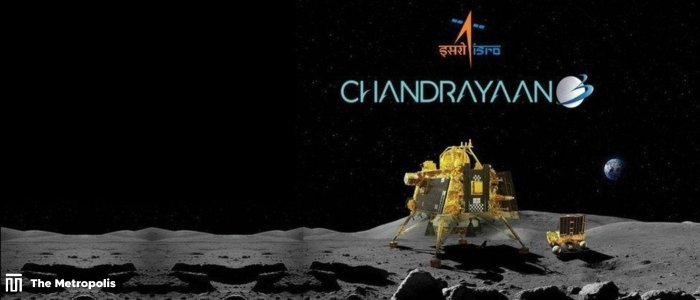An ISRO graphic of the lander and rover on the Moon’s surface-ISRO
Metropolis Desk-
By being the first country to touch down close to the Moon’s south pole on Wednesday, India hopes to make history.
Finding water-based ice, which experts say could one day enable future human habitation on the Moon, is one of the mission’s main objectives.
India would be the fourth nation to successfully make a soft landing on the moon if Chandrayaan-3 were to be successful. India’s effort happened only a few days after Russia’s Luna-25 crashed while attempting to land in the same area.
In the hunt for water ice, the south pole of the Moon bears particular promise. There is a sizable surface area that remains permanently in darkness, and scientists believe this indicates that water may be present in these regions.
All three countries—the US, the former Soviet Union, and China—have made soft landings close to the equator of the moon, but none have taken charge of missions that have reached the planet’s south pole.
Chandrayaan-2, an Indian spacecraft, crashed into the lunar surface during a failed effort to land it close to the south pole in 2019. Therefore, Chandrayaan-3, its third expedition to the little-explored Moon, is the center of attention right now.
The orbiter, lander, and rover-equipped spacecraft took flight on July 14 from the Sriharikota space center in southern India. The 26kg rover is called Pragyaan, the Sanskrit word for wisdom, and is carried within the lander, which was given the name Vikram in honor of the founder of the Indian Space Research Organization (Isro), Vikram Sarabhai.
Nilesh M. Desai of Isro told the ANI news agency that once the descent begins, the lander’s speed will gradually decrease from 1.68 km/s at its current height to virtually nil by the time it reaches 800 m.
Vikram will descend to a height of 150 meters before a decision is made on its landing spot. To find a better landing location, the lander will shift a little to the left or right if it is determined that the area is inappropriate. According to Mr. Desai, the emergency mode will engage if all else fails and aid in a safe landing.
The six-wheeled rover will emerge from the lander’s belly after it touches down and begins to move over the Moon’s surface, gathering important information and photographs that will be transmitted to the orbiter for transmission to Earth.
An official told the BBC that the wheels of the rover had the Isro’s brand and insignia engraved on them so that they leave imprints on the lunar dirt during the Moonwalk.
India is quite excited about Chandrayaan-3’s voyage to the Moon, and good luck messages are coming in from throughout the country.
The landing will be broadcast live, and millions of people, including kids, are expected to watch, according to Isro.
Sreedhara Panicker Somanath, the head of Isro, told the Hindustan Times on Tuesday that they had created “back-ups of the back-up plans” and were therefore “extremely confident of a successful landing.” He claimed that to correct the bugs, they had thoroughly examined the Chandrayaan-2 crash data and ran simulation exercises.
The camera on the Vikram lander has been extensively studying the lunar surface over the last few days as it looks for a secure landing area.
The mission is “on schedule, systems are undergoing regular checks, and smooth sailing is continuing,” Isro stated in its update on Tuesday.
The success of India’s previous Moon missions will be built upon by Chandrayaan-3, according to Mr. Somanath, who also stated that the mission will contribute to some “very substantial” scientific discoveries.
The nation’s first Moon mission, Chandrayaan-1, in 2008, confirmed that the Moon has an atmosphere during the daylight and found water molecules on the barren lunar surface.
Chandrayaan-2 was not entirely a loss, however, as its orbiter is still circling the Moon and will aid the Vikram lander in sending photographs and data to Earth for study.
The lander and the rover are carrying five scientific instruments which will help discover “the physical characteristics of the surface of the Moon, the atmosphere close to the surface, and the tectonic activity to study what goes on below the surface”.
The time of the landing has been carefully chosen to correspond with the beginning of a lunar day.
The lander and rover will get 14 days of sunlight to charge their batteries because one day on the Moon is equal to 28 days on Earth. They will stop operating and discharge once darkness falls.
It is not yet known if they will reanimate when the following lunar day begins.
There is a rising worldwide interest in the Moon, and many more missions will soon be traveling to its surface, so India is not the only country keeping a watch on it. In addition, experts assert that there is still more to learn about the Moon, which is frequently referred to as a portal to deep space.
They claim that Chandrayaan-3’s success will advance our efforts in this direction.
Source- BBC News



